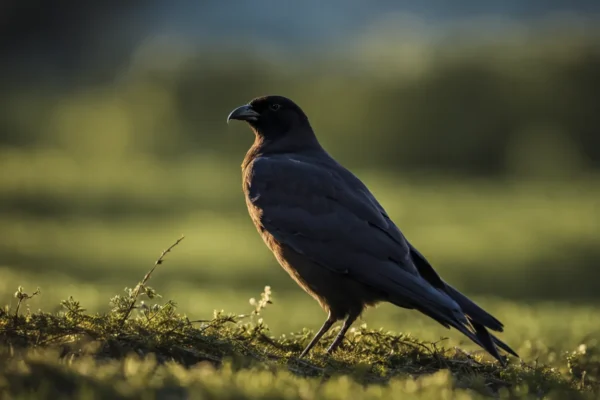Many all-black birds have an almost identical appearance up close—a midnight shadow darting across the sky or darting from branch to branch. However, not every bird with black feathers is made equally. Even though they may seem similar, crows, ravens, and certain blackbirds have unique characteristics that become apparent upon closer inspection.
Continue reading to discover the essential characteristics, habits, cries, and origins of these common sooty-feathered birds.
This is a simple response in case you’re pressed for time: Although blackbirds, ravens, and crows share similar physical characteristics, they differ in other ways. The tails of crows are fan-shaped and smaller. Ravens have longer tails that are wedge-shaped. Cowbirds and grackles are among the species of blackbirds.
Differentiating Between Physical Features and Sizes
There are discernible variations in size between blackbirds, crows, and ravens. The smallest of the three, crows are between 17 and 21 inches long and weigh between 12 and 16 ounces.
Black birds, on the other hand, weigh between 14 and 18 ounces on average and are somewhat bigger, measuring between 18 and 22 inches in length. But with lengths of up to 27 inches and weights ranging from 24 to 40 ounces, ravens claim the title of biggest animal.
Thus, the likelihood is that a black bird bigger than a crow is a raven.
Shape of the Tail
The curve of their tails is one way to tell these black-feathered birds apart. Black birds and crows have circular tail tips that resemble fans. Ravens, on the other hand, have wedge-shaped tails that, while in flight, resemble diamonds.
The raven’s characteristic tail shape might help you identify it from other black birds.
Size and Form of the Beak
The size and form of their beaks is another characteristic that sets them apart. The narrower, straighter beak of a crow is designed to allow it to eat a broad range of foods, such as fruits, insects, and carrion. Contrarily, black birds can more readily pry apart seeds and nuts due to their somewhat bigger, more curved beaks.
Among the three, ravens have the biggest and strongest beaks, which they employ to eat bigger food like small animals and birds.
Variations in Plumage
Despite the fact that all three birds are black, their plumage differs somewhat, which might aid in identification. Crows’ shiny, evenly black feathers are striking. Conversely, in some lighting circumstances, black birds may exhibit a modest iridescence, reflecting shades of blue or purple.
The most diversified in terms of plumage, raccoons have a unique appearance due to their shaggy appearance, particularly around the neck region.
It’s crucial to remember that these physical traits might differ somewhat amongst people and can be impacted by things like age, region, and subspecies. It’s advised to refer to field guides or reliable birding websites like Audubon or All About species to get a more thorough knowledge of these species.
Distinctive Habitats And Behaviors
Despite having black feathers in common, black birds, crows, and ravens are entirely different from one another in terms of their habits and environments.
Diet And Foraging
There are subtle distinctions between black birds, crows, and ravens in terms of food and foraging. Primarily insectivorous, blackbirds and starlings consume a wide range of insects, worms, and other invertebrates for their food.
Conversely, crows have a more omnivorous diet and will consume everything from small animals and carrion to fruits and seeds. While their diets are similar to that of crows, ravens are noted for being more opportunistic scavengers, often consuming bigger corpses and even trash in metropolitan areas.
Patterns of Flocking
Blackbirds are quite gregarious and often gather in big groups, particularly while migrating. These bird flocks, which may number in the hundreds or even thousands, make for a striking picture in the sky. Another gregarious bird, crows may be observed in small to huge groups, which are referred to as murders.
On the other hand, ravens are mostly solitary birds that are usually seen in pairs or small family groups.
Nesting Locations
Crows, ravens, and black birds have distinct preferences when it comes to nest places. There are many different places where black birds may be seen making their nests, including trees, bushes, and even man-made buildings. Crows often construct their nests in towering trees that are close to water sources.
Conversely, ravens like to build their nests in remote locations like cliffs or towering trees.
Geographical Range
Crows, ravens, and black birds may have varying geographic ranges. While European starlings were brought to North America and are now widespread throughout the continent, black birds, like red-winged blackbirds, are native to the continent.
Crows are widely distributed across North America, Europe, Asia, and even certain regions of Africa, inhabiting a variety of habitats. In contrast, ravens are more often found in the Northern Hemisphere, which includes Asia, Europe, and North America.
It is possible for nature lovers and bird enthusiasts to recognize the variety and beauty of these common black-feathered birds by learning about the distinct habits and habitats of black birds, crows, and ravens.
Appealing Voices and Screams
Raven Croaks vs. Crow Caws
In terms of vocalizations, ravens and crows employ distinct sounds for communication. The distinctive and loud cawing sound made by crows is well-known. Crows use cawing, which is audible from a distance, to mark their territory or alert other crows to possible threats.
Ravens, on the other hand, croak with a deeper, more visceral sound. A common description of their croaks is that they resemble a low, rough grunt.
Crows and ravens use these vocalizations for diverse objectives. Ravens utilize their croaking to establish dominance and communicate with other ravens, whereas crows use their cawing to communicate with each other and protect their territory.
These two birds vary in many ways, their sounds being only one of them.
Blackbird Songs and Calls
Like crows and ravens, blackbirds may be identified by their unique cries and songs. Male blackbirds are recognized for their lovely and musical songs, which they use to mark their territory and entice females. These songs often combine whistles, trills, and warbles to produce a distinctive and lovely melody.
The cry of female blackbirds, however, is quieter and more basic. They often call with a brief succession of notes or a gentle chirp. Their primary purposes for making these cries are to communicate with their partner or to alert their young to danger.
Capability to Mimic
Blackbirds are not as good at copying noises as crows and ravens, but they are nonetheless intelligent birds. They can imitate other animals, although not as well as ravens and crows.
Blackbirds are not recognized for their wide range of mimicry, however they are capable of mimicking a few basic sounds, such as alarms or other bird cries.
However, it has been shown that ravens and crows imitate a variety of noises, such as human speech, automobile alarms, and even the cries of other bird species. Their capacity for mimicry enables them to adjust to their environment and use various forms of communication.
Relationships Between Evolution and Taxonomy
We may better appreciate the distinctive traits and behaviors of black-feathered birds, such as ravens, crows, and blackbirds, if we are aware of their taxonomy and evolutionary links. Now let’s explore these amazing species’ scientific categorization, genetic makeup, and ancestry.
Classification of Science
Ornithologists are still researching and debating the taxonomy of black birds. But as far as is currently known, ravens, crows, and blackbirds are all members of the same family—the Corvidae—which has over 120 species.
Blackbirds belong to the genus Turdus, crows to the genus Corvus, and ravens to the genus Corvus within this family. These birds have significant features that differentiate them while having a similar look.
Analysis of Genetics
Modern genomic research techniques have yielded important new information on the evolutionary links among black birds. To learn more about the genetic similarities and differences between the several species that make up the Corvidae family, scientists have examined their DNA.
The findings show that the relationships between crows and ravens are closer than those between blackbirds. Their common physical characteristics and behaviors are supported by this genetic data.
Origins and Progenitors
Crows, ravens, and blackbirds may all be traced back millions of years to their progenitors. Fossil evidence suggests that they shared ancestors between 10 and 15 million years ago, during the Late Miocene epoch.
It is thought that a common ancestor of these birds lived in prehistoric woods. They developed unique traits and adapted to a variety of habitats throughout time, enabling them to flourish in a variety of settings.
It’s vital to remember that while blackbirds, crows, and ravens are similar in certain ways, they differ in their habits, vocalizations, and physical characteristics. We may better appreciate the great variety of the avian world and the intriguing adaptations that have molded these amazing black-feathered birds by having a solid understanding of their taxonomy and evolutionary links.
Positive And Negative Human-Agricultural Interactions Agricultural Pest Management
The ability of black birds, crows, and ravens to manage agricultural pests is one beneficial relationship they have with humans. These birds are well-known for their prowess in scavenging and for their ability to identify pests that might harm crops, such as insects and tiny rodents.
These birds assist in naturally controlling insect populations without the use of hazardous pesticides, an advantage that farmers have long understood. Crows and ravens are useful friends in the battle against agricultural pests since studies have shown that they significantly reduce crop loss caused by pests.
Proliferating Illness
However, one unfavorable relationship that exists between black birds, crows, and ravens and people is that they may carry sickness. These birds may operate as vectors by spreading viruses via their droppings or feathers, even though they are not direct disease carriers.
This is especially problematic in metropolitan areas where ravens, crows, and huge groups of black birds congregate. It is crucial that people take safety measures while around these birds, such putting on gloves when cleaning up poop or avoiding touching the feathers directly.
Cultural Illustrations
Ravens, crows, and black birds have long been associated with culture and are seen in many myths and folktales worldwide. These birds are revered as representations of wisdom, intellect, and even divinity in various civilizations.
For instance, the god of knowledge Odin had two ravens called Huginn and Muninn who would bring him information from all across the globe in Norse mythology. On the other hand, black birds, especially crows, have been connected to death or ill luck in some Western societies.
People’s impressions of and relationships with these birds may be influenced by these cultural representations.
Studies on Avian Intelligence
Ravens, crows, and black birds are renowned for their great intellect and capacity for problem-solving. Numerous studies on them have shown their aptitude for using tools, working through challenging problems, and even reading facial emotions in people.
These investigations have clarified the extraordinary cognitive capacities of these birds and advanced our understanding of the development of animal intelligence. These black birds are at the vanguard of scientific investigations into the depths of avian intelligence.
Final Thoughts
Although they can seem alike from a distance, crows, ravens, and blackbirds differ in their unique characteristics, habits, and places of origin. Differentiating between these sooty-colored birds may be facilitated by closely observing field markings like as tail form, sounds, habitat, and more.
We may enjoy the variety among bird families when we recognize their contrasts and similarities.






